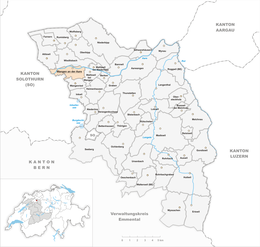Wangen an der Aare
| Wangen an der Aare | ||
|---|---|---|
 |
||
|
||
| Coordinates: 47°14′N 7°39′E / 47.233°N 7.650°ECoordinates: 47°14′N 7°39′E / 47.233°N 7.650°E | ||
| Country | Switzerland | |
| Canton | Bern | |
| District | Oberaargau | |
| Area | ||
| • Total | 5.23 km2 (2.02 sq mi) | |
| Elevation | 423 m (1,388 ft) | |
| Population (Dec 2015) | ||
| • Total | 2,274 | |
| • Density | 430/km2 (1,100/sq mi) | |
| Postal code | 3380 | |
| SFOS number | 0992 | |
| Surrounded by | Attiswil, Deitingen (SO), Flumenthal (SO), Walliswil bei Wangen, Wangenried, Wiedlisbach | |
| Website |
www SFSO statistics |
|
Wangen an der Aare is a municipality in the Oberaargau administrative district in the canton of Bern in Switzerland.
This small town lies between Olten and Solothurn in rural surroundings on the Aare, a major river of the west-central lowland region of Switzerland, the Mittelland. An ancient wooden covered bridge crosses the Aare at this point. Wangen an der Aare was the administrative centre of the former district of the same name.
Wangen is situated on the Biel/Bienne - Olten railway line and close to the A1 motorway.
Wang(en) means an area at the foot of a slope; in this case the slope in question is almost certainly that of the nearby Jura mountain range. Wangen's coat of arms shows crossed St Peter's keys in blue on a white ground. The nobles (or Vögte) who held the lordship of Wangen adopted this symbol which had been the badge of the Upper Aargau estates of the Abbey of Saint Peter in the Black Forest. The earliest document to be sealed with the crossed-keys symbol dates from the year 1380.
The castle, built by the Kyburger dynasty in 1407, became the seat of the Bernese regional governorship, and some departments of the regional administration are still housed in the building today. The settlement occupied a strategically important spot, guarding the river-crossing and serving as a customs and staging-point for waterway traffic on the Aare. When the latter trade came to an end the little town experienced a serious economic crisis. The salt house of 1775 remains today as a testament to this past.
Wangen has an area of 5.2 km2 (2.0 sq mi). Of this area, 42.8% is used for agricultural purposes, while 28.8% is forested. Of the rest of the land, 20.3% is settled (buildings or roads) and the remainder (8.1%) is non-productive (rivers, glaciers or mountains).
...
Wikipedia




